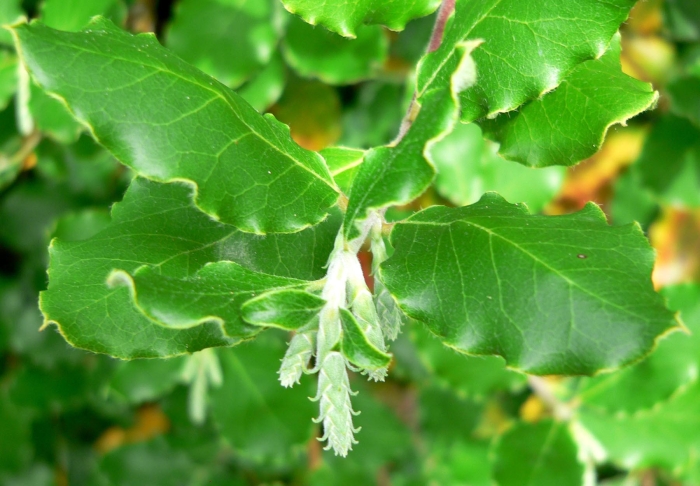Wavyleaf Silktassel
(Garrya elliptica)
Wavyleaf Silktassel (Garrya elliptica)
/
/

Stan Shebs
CC BY-SA 3.0
Image By:
Stan Shebs
Recorded By:
Copyright:
CC BY-SA 3.0
Copyright Notice:
Photo by: Stan Shebs | License Type: CC BY-SA 3.0 | License URL: https://creativecommons.org/licenses/by-sa/3.0 | Uploader: Stan Shebs | Publisher: Wikimedia Commons | Title: Garrya_elliptica_James_Roof_1.jpg | Notes: {{Information |Description=Yellow flowers of ''Gazania rigens'' |Source=self-made |Date=May 2007 |Author= [[User:Alvesgaspar|]] }} [[Category:Gazania]] |












































































Estimated Native Range
Summary
Garrya elliptica, commonly known as Wavyleaf Silktassel, is an evergreen shrub or small tree native to the coastal forests and chaparral regions of California and Oregon. It typically grows to a height of 2–5 meters (7–16 feet) with a multi-furcate branching structure, creating an almost spherical form. The average height in the wild is approximately 3 meters (9.8 feet). Wavyleaf Silktassel is characterized by its waxy, convex leaves with distinctive wavy margins and dense, fine hairs on the leaf undersides that are difficult to see without magnification. The plant is particularly noted for its long, pendulous catkins, which appear in late winter to early spring and can be quite showy, ranging in color from cream to yellow, silver, green, and white.
Wavyleaf Silktassel is valued for its neat growing habit and ornamental catkins, making it a popular choice for landscape use, especially as a windbreak in coastal areas or against a wall. It is also appreciated for its ability to tolerate moderately heavy clay soils and serpentine substrates, as well as its resistance to grazing by deer and rabbits. While hardy to cold temperatures down to 15 °F (−9 °C), it thrives with an annual rainfall of about 25 inches (64 cm). For optimal growth, it prefers full sun but can also tolerate part shade, and it adapts to a range of soil drainage conditions from slow to fast. It is moderately drought-tolerant but benefits from occasional watering during prolonged dry periods.CC BY-SA 4.0
Wavyleaf Silktassel is valued for its neat growing habit and ornamental catkins, making it a popular choice for landscape use, especially as a windbreak in coastal areas or against a wall. It is also appreciated for its ability to tolerate moderately heavy clay soils and serpentine substrates, as well as its resistance to grazing by deer and rabbits. While hardy to cold temperatures down to 15 °F (−9 °C), it thrives with an annual rainfall of about 25 inches (64 cm). For optimal growth, it prefers full sun but can also tolerate part shade, and it adapts to a range of soil drainage conditions from slow to fast. It is moderately drought-tolerant but benefits from occasional watering during prolonged dry periods.CC BY-SA 4.0
Plant Description
- Plant Type: Shrub, Tree
- Height: 12-15 feet
- Width: 8-12 feet
- Growth Rate: Moderate
- Flower Color: N/A
- Flowering Season: Winter
- Leaf Retention: Evergreen
Growth Requirements
- Sun: Full Sun, Part Shade
- Water: Low, Medium
- Drainage: Slow, Medium, Fast
Common Uses
Bee Garden, Bird Garden, Butterfly Garden, Deer Resistant, Drought Tolerant, Erosion Control, Hedges, Low Maintenance, Salt Tolerant, Street Planting
Natural Habitat
Coastal forests and chaparral regions of California and Oregon
Other Names
Common Names: Coast Silk-Tassel, Silk Tassel Bush
Scientific Names: , Garrya elliptica, Garrya lindleyana,
GBIF Accepted Name: Garrya elliptica Douglas ex Lindl.